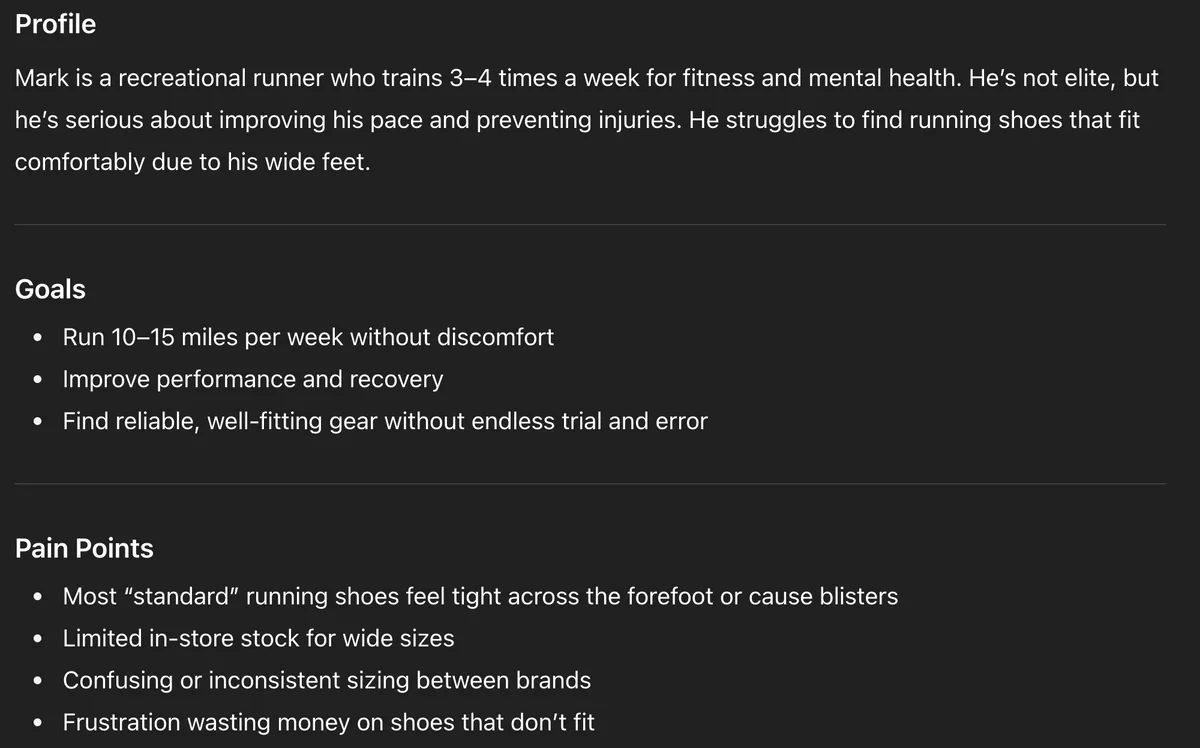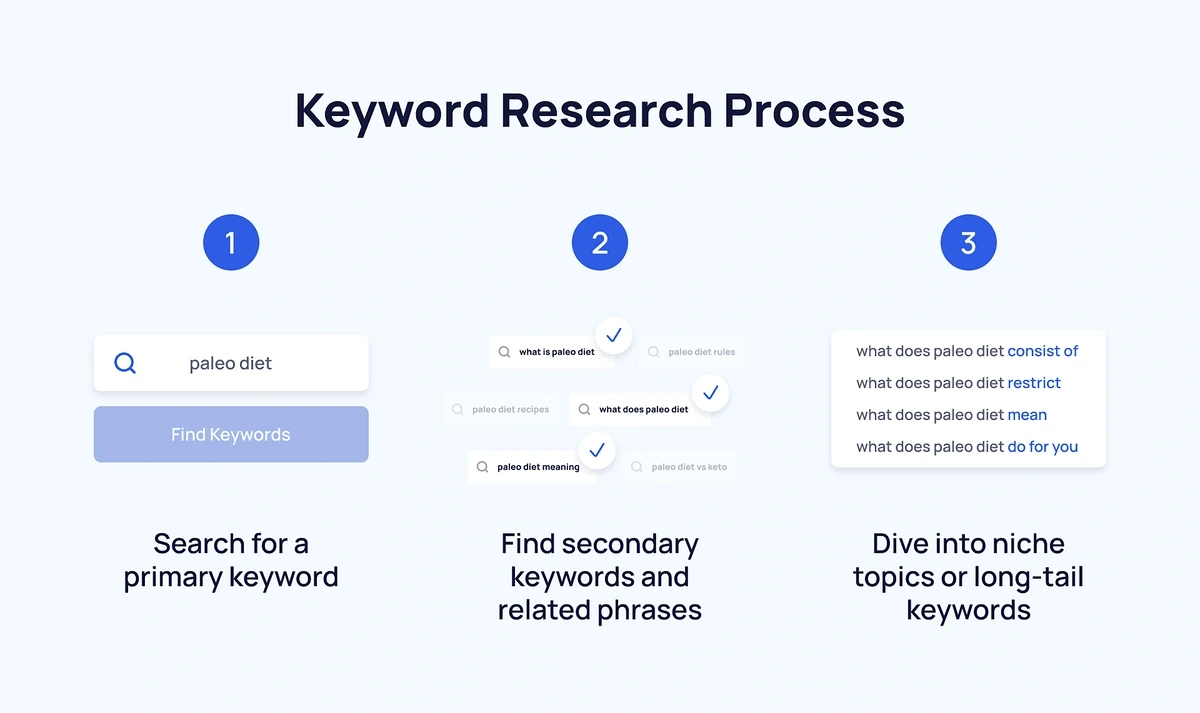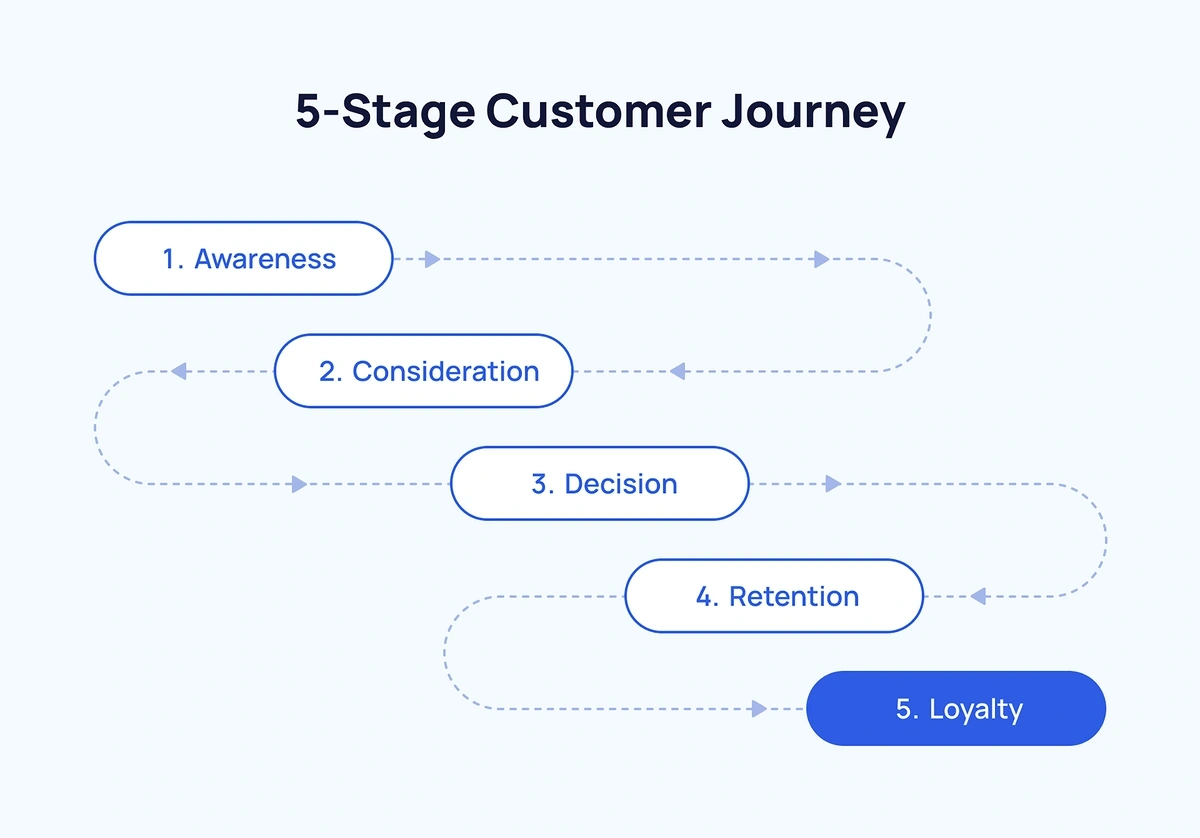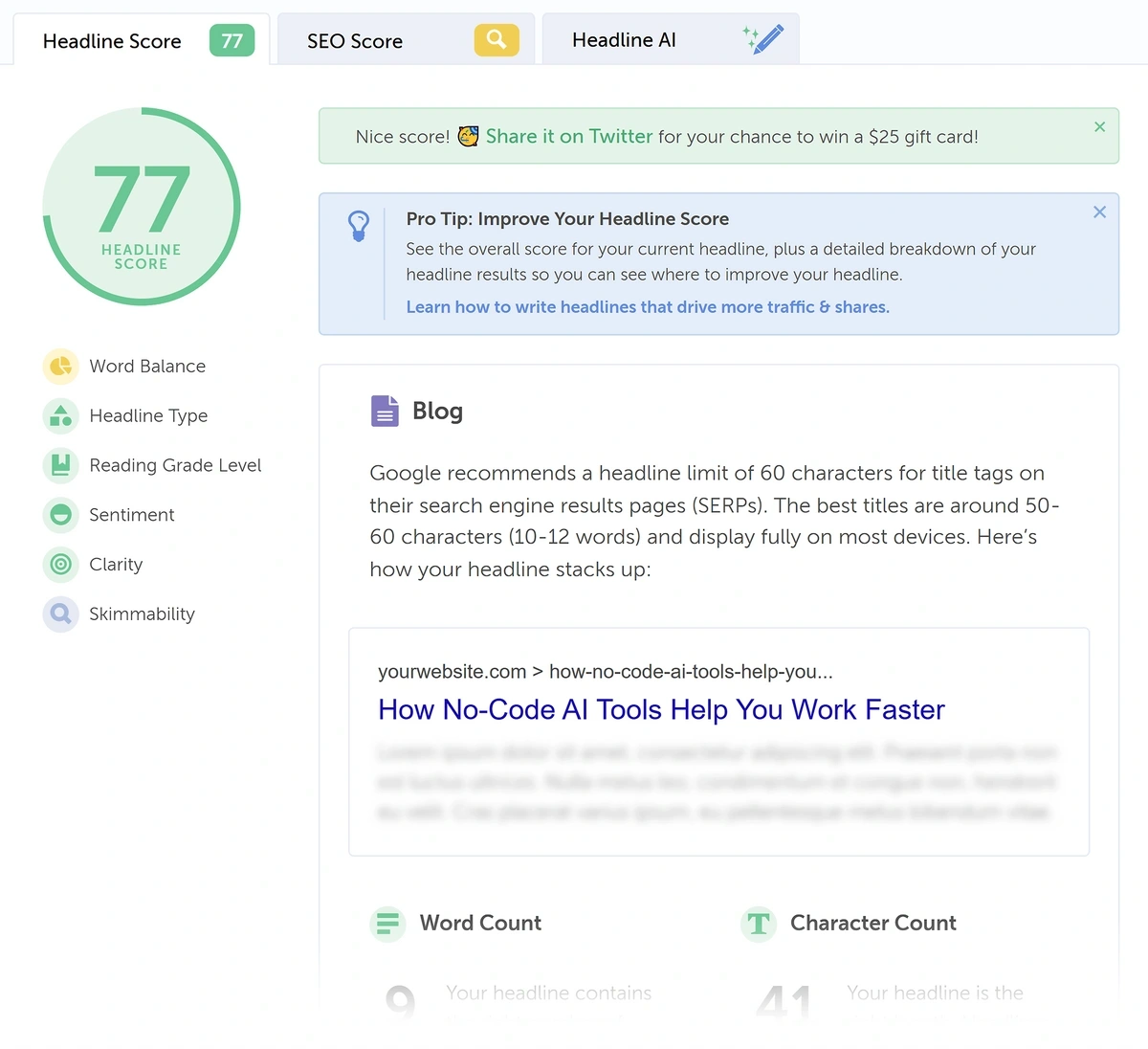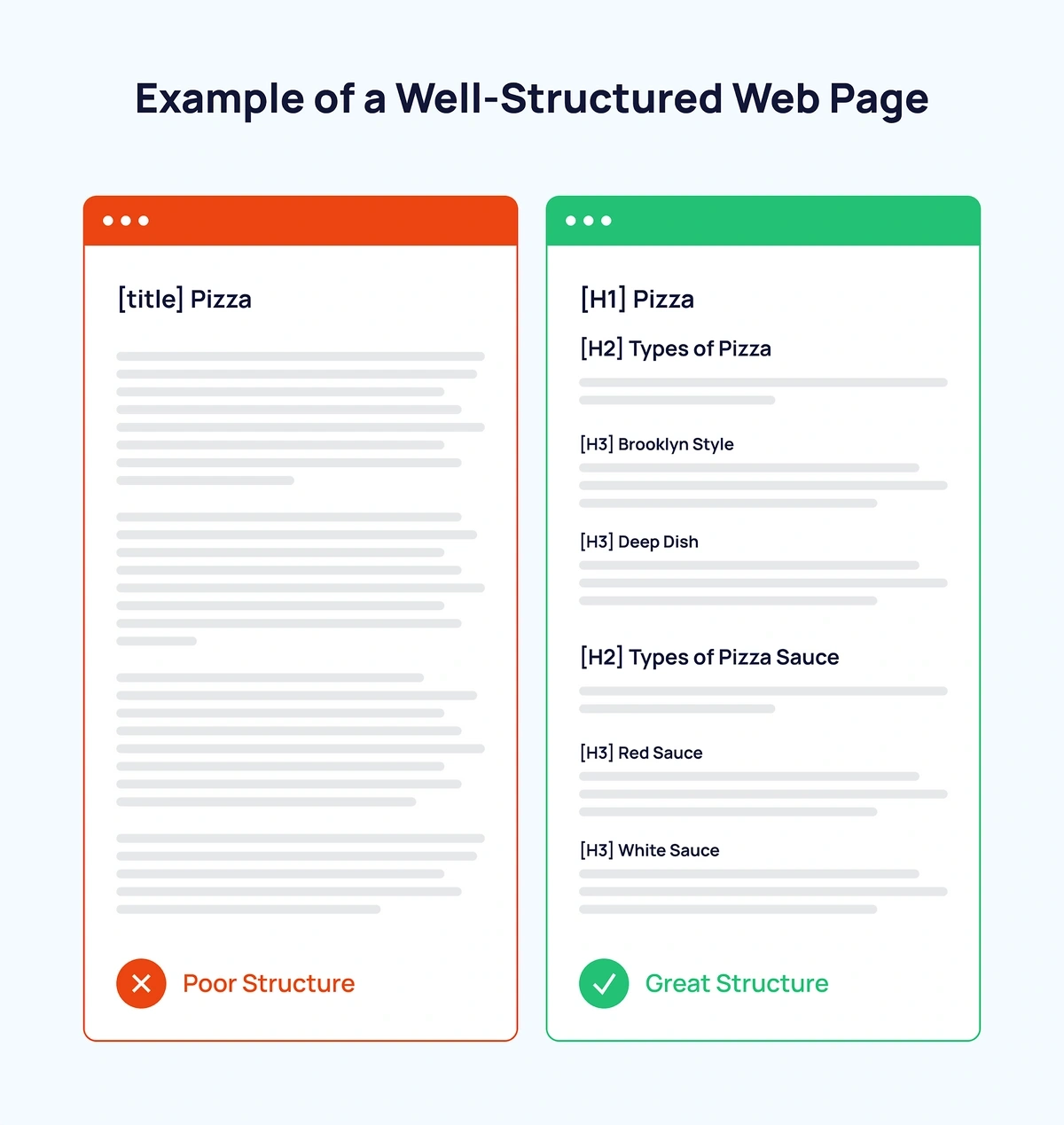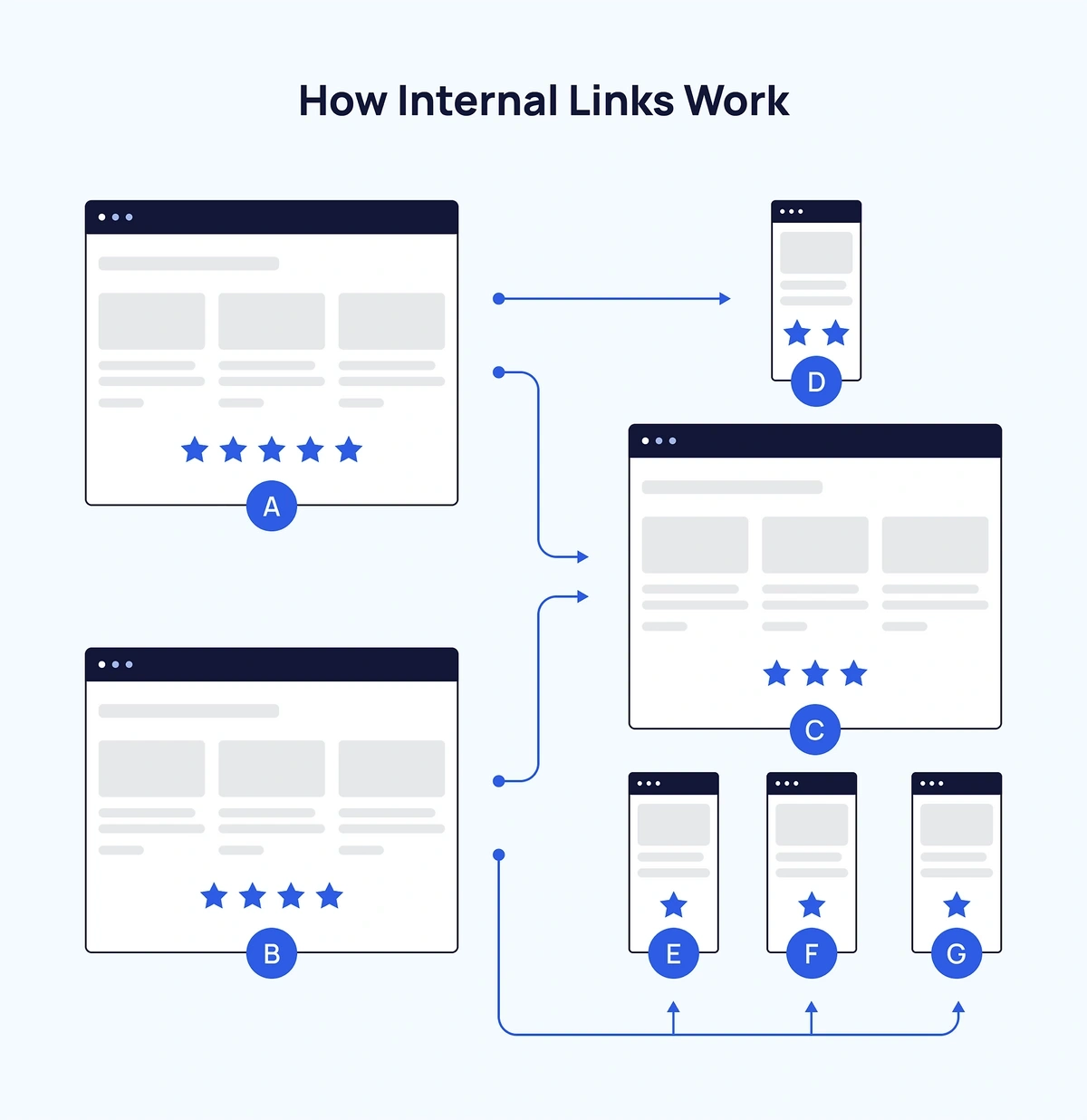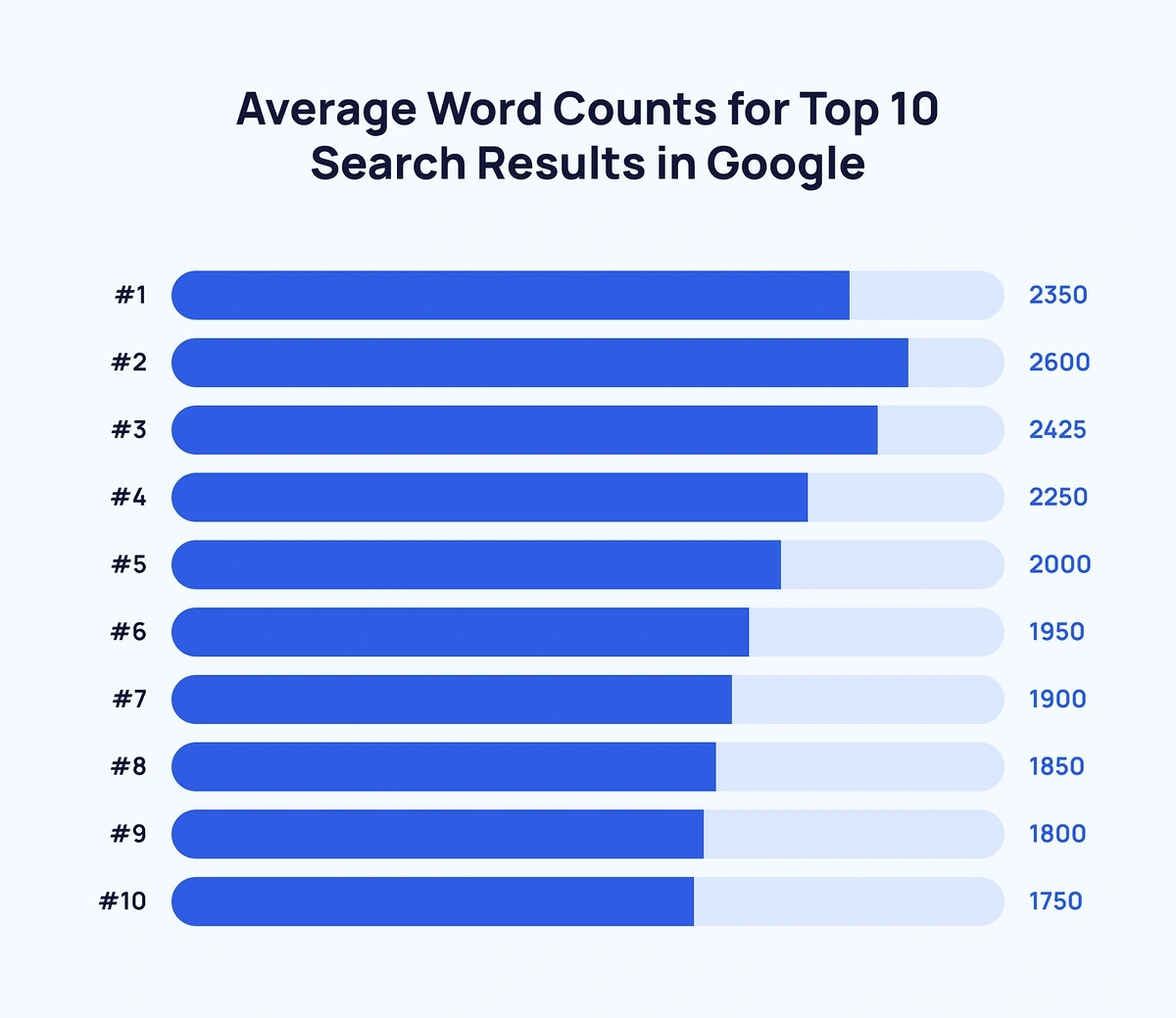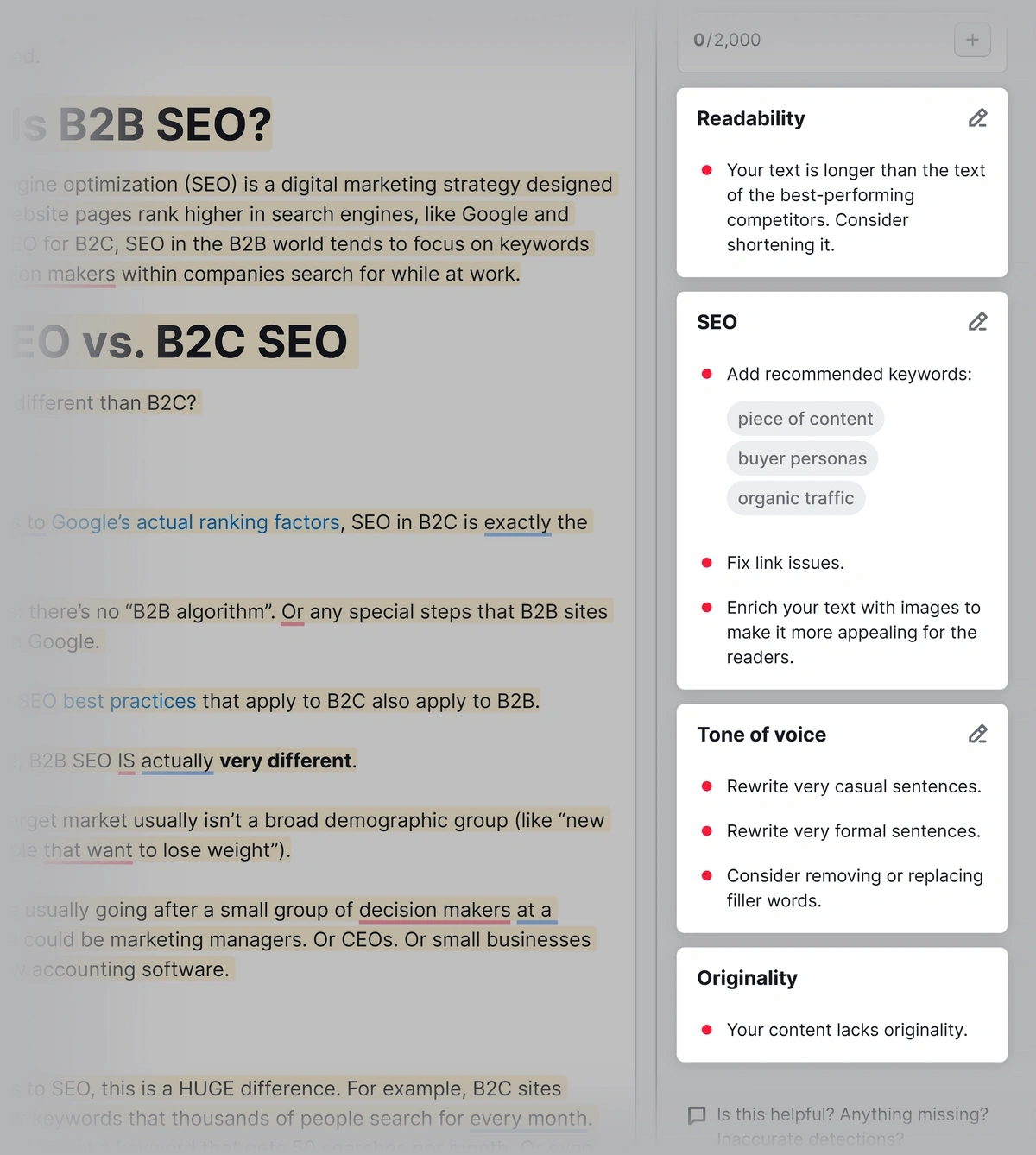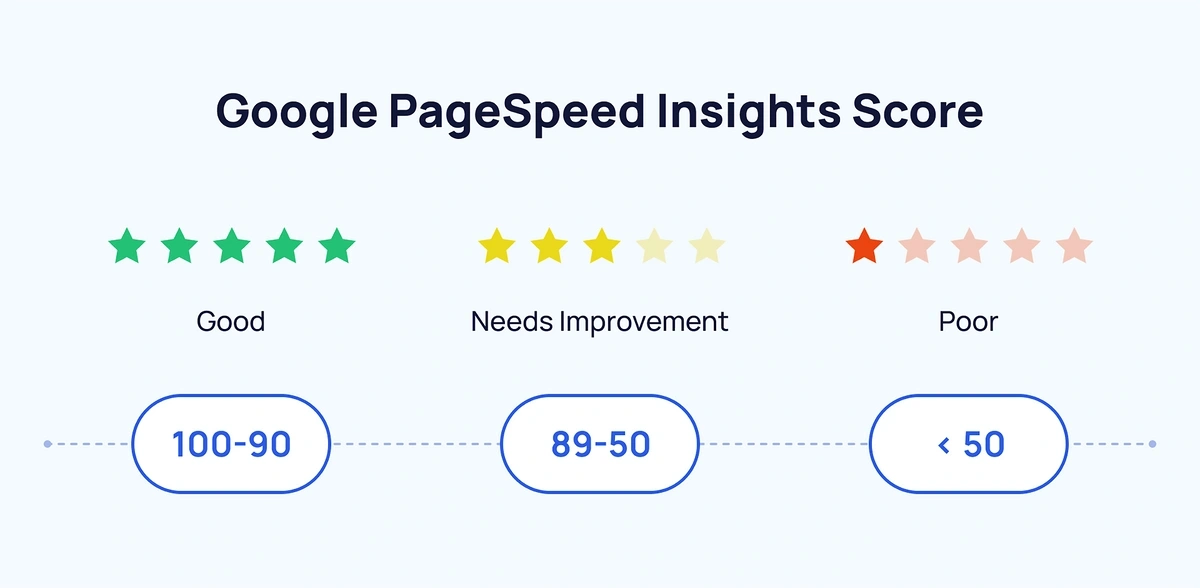
SEO Copywriting Checklist: 12 Steps to Make Your Content Rank
An SEO copywriting checklist will help you to ensure that your content meets the needs of your website visitors.
When content resonates with people, Google picks up on those signals and rewards the content with better rankings. Each piece of content is needs to support topical authority while also being helpful, accurate, and complete.
Since SEO copywriting is complex, I’m going to break this down into a checklist that you can refer to as you work on your content.
1. Know Your Audience
Before we work on updating the content, we need to understand who it’s for.
The first task in your SEO copywriting checklist should be a reader profile.
Start by defining your ideal customer:
- Their age
- Where they live
- What they're interested in
- The challenges they face
- What their problems are, and how your product or service might help them
The more specific you are when building a reader profile (or persona), the easier it becomes to tailor your message to their needs. Give your ideal readers names, jobs, and hobbies, for example.
Your persona is just a guess. But it’s helpful to get the reader clearly defined. It allows you to use the right tone as you write.
Customer intelligence platforms can help you gather data about your ideal customer.
You can also use ChatGPT to quickly develop a persona that you can refer to. Just tell it a few facts about your customers and it will expand on those with new ideas and angles.
Once you have a persona, it’s time to think about how your audience searches.
- Find out what words and phrases they use. Knowing how your readers communicate makes your content feel personal and relatable.
- See what questions they're asking. You can find specific needs and concerns by mining People Also Ask data.
Don’t be afraid to use AI SEO tools to help you with this part.
Want to Spy on Your Competition?
Explore competitors’ website traffic stats, discover growth points, and expand your market share.
2. Conduct Keyword Research
Choosing the right keywords is the cornerstone of effective search engine optimization.
Without them, your content may never reach the people seeking it.
Add our free keyword research tool to your SEO copywriting checklist so you can easily get keyword ideas.
Here’s a basic outline of the process:
- Using our keyword tool, search for a primary keyword that closely matches your topic. This is the main term you want to rank for. It’s sometimes called a seed keyword.
- The tool will show you secondary keywords and related phrases that support your seed keyword. These additional search terms enrich your content and increase your chances of appearing in more search results.
- Using a tool like Semrush, dive into niche topics or long-tail keywords that match your audience's specific interests. These are very detailed queries that might have lower search volumes but which attract more qualified visitors.
Long-tail keywords tend to have less competition, giving you a prime opportunity to connect with readers who are looking for exactly what you provide.
Next, you need to understand the search intent behind each keyword:
- Are people using this term to find information?
- Do they want to navigate to a particular site, brand, or app?
- Are they ready to make a purchase or subscribe to a service?
Knowing why users search for a given keyword helps you tailor your SEO copy to meet their needs and expectations.
As you plan your content, consider the Skyscraper technique. This involves finding popular content related to your keywords, then creating something even better. Doing this repeatedly builds topical authority.
I like to use the Semrush Keyword Strategy Builder to get all of my related keywords into one place. From there, I can start to plan what I want to write about.
3. Plan Content
Once you know your ideal readers and what they’re looking for, it’s time to plan your content.
You should already have a persona in mind. (You may have more than one, so just select the best fit for the topic.)
After that, consider what actions you want your persona to take. These actions will coincide with your site’s conversion goals, like signing up to a mailing list or placing an order.
Next, determine how your content maps to the customer journey. Your target keyword’s search intent will inform what part of the journey your content should address.
As part of your broader SEO strategy, take time to analyze your competitors. Look at the top-ranking pages for your chosen keywords to see how they're using them.
- How is the competition covering this topic?
- What content have you published on it in the past?
- Can you repurpose or improve on old content?
- What gaps can you fill with a new page?
Now, begin researching the topic in depth:
- Look for high-authority resources and build on what you learn from them. This will give your content greater authority. In our research into the future of SEO, we found that demonstrating authority is increasingly important.
- Dig into forums like Quora and Reddit to uncover common questions and concerns related to your topic. This direct insight helps you understand the issues your readers care about most, so you can address them effectively in your writing.
Once you know what needs to be covered, draft a content brief to outline your piece:
- Map out the structure, key points, and subtopics you want to cover
- Identify spots where you can include internal links to other relevant content on your site
- Brainstorm what the call to action can best move the customer onto the next stage of their journey
- Use specific keywords in headings as you structure the post.
These steps ensure your content is thorough and logically organized, making it easier for readers to follow and for search engines to index.
It’s important to think about intent as you do this so you can avoid getting sidetracked.
Need help planning your content? Use the free Semrush Content Strategy Template to make sure you don’t miss a step!
4. Optimize Headline
Here’s one of my favorite SEO copywriting tips: think of your headline as an elevator pitch.
The headline sets the stage for the rest of your content. That’s why a strong headline can significantly impact your content's performance in search results.
If you’re not sure where to start, place your primary keyword at the very beginning of your headline. Then write the rest of the headline in a way that describes the topics you’ve covered.
For example, if your main keyword is "digital marketing tips," a headline like "Digital Marketing Tips to Boost Your Sales" is clearer than "Boost Your Sales with These Digital Marketing Tips."
To make your headline more engaging, tap into curiosity or emotion. Use numbers, strong adjectives, or ask a question.
For example:
- "10 Surprising Digital Marketing Tips You Haven't Tried"
- "Struggling with Low Online Sales? These Digital Marketing Tips Can Help"
- "Want More Traffic? Try These Digital Marketing Strategies"
These techniques make your headline more compelling and increase the likelihood that someone will click.
It's also a good idea to test your headlines before finalizing them. Tools like CoSchedule's Headline Analyzer can provide feedback on their effectiveness.
Coschedule calculates an engagement score for your headline based on how it might perform in organic search results. A higher score means your headline is more likely to attract attention and encourage clicks.
It will also offer some attributes indicating where your headline works well—and where it needs improvement.
5. Review Structure
A well-organized article keeps your readers engaged while also helping search engines understand your content.
Begin by structuring your piece with clear headings and subheadings.
Use:
- H1 tags for your main title
- H2 tags for primary sections
- H3 tags for subsections
This hierarchy makes it easy for readers to follow along and allows search engines to grasp the main topics you're covering.
Break large chunks of text into shorter paragraphs—ideally no more than two or three sentences each. This prevents your content from feeling overwhelming and makes it more approachable.
A huge block of text can look very overwhelming. Text that is broken up makes skim-reading easier.
A few other things to consider:
- Make lists: When you have multiple items or steps, incorporate bullet points for easier reading and to highlight important information. (If the items in the list need to be completed in order, use a numbered list instead of bullets.)
- Consider graphics: Some information is more easily digested in a table, chart, or other visual representation. I like to use Napkin.ai to generate quick charts.
- Use callouts: Block quotes, pull quotes, and other techniques can draw attention to key points and takeaways.
As you write, naturally integrate your primary and secondary keywords throughout the text. Don't force them in. Let them fit smoothly into your sentences.
Include related terms and synonyms to add depth and context. This helps search engines associate your content with a broader range of search queries.
For example, when writing about “pizza,” mention both common and uncommon pizza toppings that your audience may like. You’ll also want to talk about regional styles and variants, such as New York-style pizza, Chicago deep dish, or Hawaiian pizza.
Structuring these topics properly will make your article more appealing to readers and more favorable to search engines.
6. Review On Page SEO
Optimizing on page SEO elements can boost your content's visibility and bring in more organic traffic.
You can refer to our complete list of ways to improve your website’s on page SEO, and use our free On-Page SEO Checker. For now, let’s summarize some of the most important points.
Meta Elements
Start by writing concise title tags and meta descriptions that include your primary keyword and give users a clear reason to click.
Because these snippets appear in search results, they have a big impact on whether someone chooses your page over others.
| Title Tags | Meta Descriptions |
| Aim for something similar to your headline, but you may need to shorten it | Short descriptions of your page can appear in search results |
| Keep the keyword near the start if possible | Aim for around 105 characters |
| Aim for 55-60 characters |
I like to use the free SISTRIX title tag preview tool to see how the title and meta description will look in the search results.
URLs
Pay attention to your URL structure. While you may not be able to change the full URL, you can likely set the slug, which is the section after the final forward slash.
Aim to:
- Use clean, descriptive slugs that incorporate your primary keyword when it makes sense
- Use hyphens to separate words in your URL (not dashes, underscores, spaces, or other characters)
- Steer clear of unnecessary parameters or random numbers that could confuse readers or search engines
A straightforward URL looks more trustworthy and is easier for people to remember. It also serves as a signal to the search engine so it has a better idea of the core topic.
Internal Linking
Don't underestimate the power of internal links. Linking pages together helps readers to navigate your site.
In addition, it helps signal the topic of each page to Google.
Linking a popular page to a new page can help to pass authority.
External Linking
Including external links to reputable sources can also add value.
It indicates that you've done your homework and are providing well-researched information. This enhances your credibility with both readers and Google.
7. Optimize for Engagement
Content review and editing is an important component of an SEO copywriting checklist.
Google looks for engagement signals, like how long people are spending on a page and how far down they scroll.
That means you need to maintain quality all the way through.
You can edit and review your own content, but sometimes it’s better to have someone else look at it. Someone who is new to the content may spot issues that you miss.
To rank higher and keep your readers engaged:
- Ensure the article thoroughly covers your topic
- Try to be the go-to resource. Dive deep into your subject and offer insights that others haven't touched on.
- Add multimedia elements like images, videos, or infographics
- Fact-check any statistics that you’ve included
- Make sure the content is valuable all the way through, avoiding repeated or redundant sections
The person who’s editing the content should keep your persona in mind. To address search intent, you’ll need to address their query fully. This will result in people reading for longer and scrolling further down as they do so.
Tip: You may have seen claims that longer articles often perform better in search results. Long articles don’t rank well just because they have more words. They tend to be more valuable and detailed, which is why readers tend to prefer them.
The ideal length depends on the topic and the complexity of the search query.
Whatever the word count, make sure every sentence adds value and contributes to your message.
8. Optimize for Readability
Some sites miss readability off their SEO copywriting checklist, which is a mistake.
To get good engagement, you first need to ensure that the content is pitched at the right level.
For example, an article on marketing that’s written for beginners will usually include explanations of basic marketing concepts. An article written for a manager or CEO wouldn’t need as much detail.
I like to use the Semrush SEO Writing Assistant to check the readability score as I’m writing.
9. Optimize Multimedia and Images
Optimizing your multimedia content is an important step in improving UX and boosting SEO.
Images
Provide clear and descriptive alt text for your images. This helps users who rely on screen readers and gives search engines context about your images, which helps them to understand the topical relevance.
When it comes to image filenames:
- Avoid uploading images with generic file names like "IMG_1234.jpg"
- Instead, rename them using relevant keywords that describe the image, such as "blue-mountain-lake.jpg"
This will improve image visibility in image search results.
To keep your website loading quickly, compress image files without sacrificing quality. Tools like TinyPNG can reduce file sizes significantly, leading to faster page loads and a better experience for your visitors.
Videos
When it comes to videos, add titles and descriptions that include keywords your audience might search for.
Including transcripts makes your content accessible to a wider audience. It also provides additional text for search engines to index.
10. Add Call to Action (CTA)
If you want your reader to take action, you need to include a CTA.
A well-placed CTA can turn a casual reader into a customer.
- Instead of generic buttons that say “Click Here” or “Contact Me”, use specific phrases like "Download Your Free Guide" or "Join Our Community Today." These not only tell the user what to do, but they also highlight what's in it for them.
- Put your CTAs where they're easily noticed—after valuable content or in areas where the user is likely to make a decision.
- Active verbs can urge immediate action. Words like "Get," "Join," or "Start" are direct and encourage users to take the next step.
Refer to your reader personas to ensure your CTAs match the problems your readers want to solve.
Here’s another example of a CTA. You’ll see this one in quite a few articles on the site:
Build a winning strategy
Get a complete view of your competitors to anticipate trends and lead your market
Thoughtfully integrated CTAs enhance the user's experience by offering them clear paths to continue their journey with you.
11. Review Technical SEO
Technical SEO lays the groundwork for your content's success. Fine-tuning your site improves both user experience and search engine visibility.
Page Load Speed
A faster site keeps visitors engaged and reduces bounce rates.
- Minimize your code with a tool like Code Beautify to remove unnecessary characters and spaces.
- Leverage browser caching so returning visitors don't have to reload the entire site.
- Enable gzip compression for smaller file sizes and faster transmission.
You can get more ideas on how to improve page load speed with Google PageSpeed Insights.
It will score your web page and give you suggestions on how to improve your page speed.
Mobile-Friendliness
Do you know whether your visitors use mobile, desktop, or both?
Most sites have visitors from a range of different devices, all with different resolutions and screen sizes. That’s why you’ll want to test your site on various devices to see how it performs.
This testing doesn’t have to be part of your SEO copywriting checklist for each new article. But it makes sense to re-test mobile responsiveness if you’ve recently changed your layout, added some new CTAs, or applied a new theme.
Structured Data
Implement structured data using schema.org markup. This helps search engines understand your content better.
With proper markup, your pages can appear with rich snippets in search results, which can boost click-through rates.
Canonical URLs
Don't overlook canonical tags. If you have similar or duplicate content on different URLs, canonical tags tell search engines which version is the main one.
This prevents duplicate content issues that could harm your rankings.
12. Plan Content Promotion
The final step in your SEO copywriting checklist is slightly different. It happens after you’ve published your content.
Once the new page is live, you’ll want to promote it.
It can take time for content to rank in organic search, so promotion gives you a head start.
Going back to the first item on the checklist, think about your persona. Where do they get their information from? You might want to share your article using:
- Social media
- Discussion forums
- Direct messages or networking
Keep in mind that each social network and discussion forum has a slightly different user base. An article that makes sense for LinkedIn might not gain traction on Facebook.
You can also try:
- Adding social media buttons, so people can share the content
- Repurposing your content into different formats. Turn a blog post into a slideshow, a podcast, or social media snippets.
This extends its lifespan and helps you reach different segments of your audience.
Next Step: Get Started With Your SEO Checklist
This SEO copywriting checklist can help position your content to rank higher and genuinely engage readers.
When you implement these strategies, you’ll create valuable content that can turn readers into loyal customers.
Semrush offers a comprehensive suite of tools designed to make each step of this process easier. Start your free trial today and begin to improve your content strategy.
If you're looking for a free SEO checklist, we've got one of those too. And our free SEO checker gives you instant personalized tips on what your site needs to fix.
Stop Guessing, Start Growing 🚀
Use real-time topic data to create content that resonates and brings results.
Exploding Topics is owned by Semrush. Our mission is to provide accurate data and expert insights on emerging trends. Unless otherwise noted, this page’s content was written by either an employee or a paid contractor of Semrush Inc.
Share
Newsletter Signup
By clicking “Subscribe” you agree to Semrush Privacy Policy and consent to Semrush using your contact data for newsletter purposes
Written By


Claire Broadley is the Lead Editor and AI Content Strategist at Exploding Topics, where she oversees editorial workflows, AI SEO s... Read more

